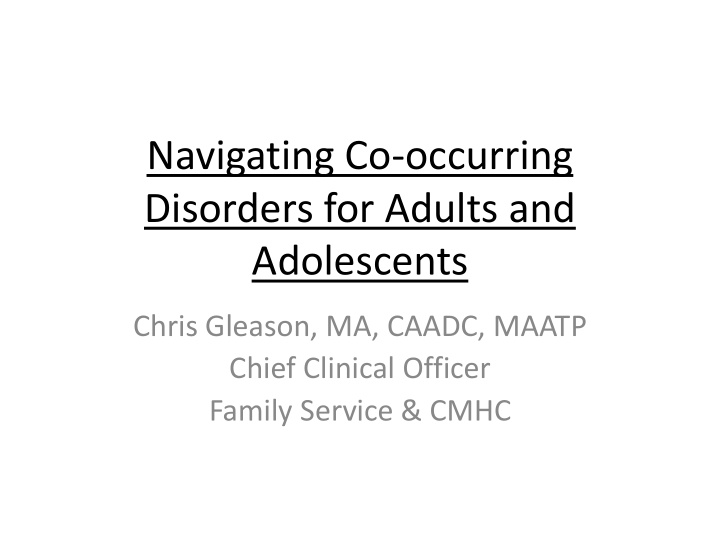



Navigating Co-occurring Disorders for Adults and Adolescents Chris Gleason, MA, CAADC, MAATP Chief Clinical Officer Family Service & CMHC
Defining Co-Occurring Disorders CSAT, 2005 • A diagnosis of co-occurring disorders occurs when at least one disorder of each type can be established independent of the other and is not simply a cluster of symptoms resulting from the one disorder 2
Prevalence of co-occurring psychiatric and substance abuse disorders: Clinical Samples • Treatment and research on this population not commensurate with the high prevalence • Among mental health treatment samples, estimates of lifetime co-morbid substance abuse samples range from 24% to 50% • Among youth who have received substance abuse treatment, estimates of lifetime co-occurring psychiatric disorder range from 59% to 87% • 45 to 49% of youth treated for substance use disorders also have co-occurring psychiatric disorders (Tenn Care) 3
Co-Occurring Psychiatric Problems * Dennis, 2009, Source: CSAT 2008 SA Dataset Adolescent Subset (n=15,882) 4 4
Co-Occurrence of Serious Mental Illness with Substance Dependence /Abuse 2002 National Survey on Drug Use and Health 4.0 million adults had both SMI and SD/A in the past year 0.8 million had SMI and dependent/abused alcohol and illicit drugs 0.9 million had SMI and dependent/abused only illicit drugs 2.4 million had SMI and dependent/abused only
Chronic Relapsing Disorder Dennis, Foss & Scott (in press) • Median Duration of 27 years from First Use to 1+ years Abstinence • It Takes Decades and Multiple Episodes of Treatment • It takes a Year of Abstinence before less than 50% relapse • Even after 3-7 years of abstinence about 14% relapse 6
Summary of Problems in the US Treatment System • Less than 26% of Adolescents in US stay the 3 months recommended by NIDA researchers • Less than half have positive discharges • After intensive treatment, less than 10% step down to outpatient care • Problems are often assessed in an unstandardized way that leads to under identification • Structural issues related to high turnover, complicated client needs, lack of data to inform clinical decision making and issues with missing or misrepresented data Dennis, 2009 7
Treating One Disorder in Isolation is not Sufficient • Substance abuse treatment helps to reduce the frequency of use and the number of abuse/dependence symptoms but has only indirect impact on emotional and behavioral problems (M. Dennis, 2004) • Psychiatric treatment alone for youth with mood disorders and co-occurring SUD does not significantly reduce substance use (Geller et al., 1998) 8
Treatment for Co-occurring Disorder • Recommended versus actual dosage of treatment for dually diagnosed youth: – 2002 Median Length of Stay is only 50 day – Less than 25% stay the 90 days or longer time recommended by NIDA Researchers Dennis, 2009 : Source: Data received through August 4, 2004 from 23 States (CA, CO, GA, HI, IA, IL, KS, MA, MD, ME, MI, MN, MO, MT, NE, NJ, OH, OK, RI, SC, TX, UT, WY) as reported in Office of Applied Studies (OAS; 2005). Treatment Episode Data Set (TEDS): 2002. Discharges from Substance Abuse Treatment Services, DASIS Series: S-25, DHHS Publication No. (SMA) 04-3967, Rockville, MD: Substance Abuse and Mental Health Services Administration. Retrieved from http://wwwdasis.samhsa.gov/teds02/2002_teds_rpt_d.pdf .
Treatment for Co-Occurring Disorders • What treatments are available? – Treatments for Substance Abuse and Mental Health Disorders • Sequential Care • Parallel Care • Coordinated Care • Integrated Care – Treatment Modalities • Outpatient • Intensive Outpatient • Inpatient • Residential
Assessment across multiple dimensions I. Diagnoses: youth who meet the criteria for both Mental Health and Substance Use diagnoses II. Contextual Functioning: Degree of functional impairment per life domain III. Developmental Functioning: (cognitive functioning, emotional, & behavioral maturity) IV. Risk and Recovery Environments : Environmental risk and recovery conditions (e.g. trauma, safety, negative influences, family conflict, poverty) 11
Influence, Interaction, and Manifestation of Co- Occurring Disorders (Shepler and Baltric) Contexts (Home, School, Peers, Community, etc.) Youth Substance Use Trauma Factors Disorder Salient Behavior/ Symptom Mental Health Risk & Resiliency Disorder Factors Developmental Factors 12
Integrated and Comprehensive Service Array Matched to Need Recovery & Resiliency ECOSYSTEMIC FUNCTIONING BASIC SKILLS BASIC NEEDS & SAFETY Youth and Family Need Hierarchy (Shepler, 1991, 1999) 13
Resources and Credit • http://coce.samhsa.gov • http://www-dev.rags.kent.edu • Dr. Rick Shepler • Dr. David Lee
Questions? Chris Gleason, MA, CAADC, MAATP Family Service & CMHC cgleason@familyservicemch.org
Recommend
More recommend